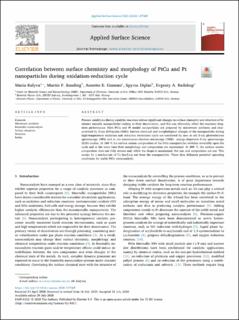| dc.contributor.author | Kalyva, Maria Evangelou | |
| dc.contributor.author | Sunding, Martin Fleissner | |
| dc.contributor.author | Gunnæs, Anette Eleonora | |
| dc.contributor.author | Diplas, Spyridon | |
| dc.contributor.author | Redekop, Evgeniy | |
| dc.date.accessioned | 2020-11-25T10:04:00Z | |
| dc.date.available | 2020-11-25T10:04:00Z | |
| dc.date.created | 2020-11-05T12:23:57Z | |
| dc.date.issued | 2020 | |
| dc.identifier.citation | Applied Surface Science. 2020, 532 1-6. | en_US |
| dc.identifier.issn | 0169-4332 | |
| dc.identifier.uri | https://hdl.handle.net/11250/2689516 | |
| dc.description.abstract | Process conditions during catalytic reactions induce significant changes in surface chemistry and structure of bi- (mono) metallic nanoparticles leading to their deactivation, and this can ultimately affect the reactions long-term performance. Here PtCu and Pt model nanoparticles are prepared by microwave synthesis and characterized by X-ray diffraction (XRD). Surface chemical and morphological changes of the nanoparticles during high-temperature oxidation and reduction treatments cycle are correlated by near in situ X-ray photoelectron spectroscopy (XPS) and ex situ transmission electron microscopy (TEM) - energy-dispersive X-ray spectroscopy (EDS) studies. At 300 °C the surface atomic composition of the PtCu nanoparticles switches reversibly upon the cycle and at the same time their morphology and composition are maintained. At 400 °C, the surface atomic composition does not fully restore and, while the shape is maintained, the size and composition are not. This occurs by a mechanism of Cu leaching out from the nanoparticles. These data delineate potential operating conditions for stable PtCu nanocatalysts. | en_US |
| dc.language.iso | eng | en_US |
| dc.publisher | Elsevier | en_US |
| dc.rights | Navngivelse 4.0 Internasjonal | * |
| dc.rights.uri | http://creativecommons.org/licenses/by/4.0/deed.no | * |
| dc.subject | Redox | en_US |
| dc.subject | Structure | en_US |
| dc.subject | Surface chemistry | en_US |
| dc.subject | Bimetallic nanocatalysts | en_US |
| dc.subject | Microwave synthesis | en_US |
| dc.title | Correlation between surface chemistry and morphology of PtCu and Pt nanoparticles during oxidation-reduction cycle | en_US |
| dc.type | Peer reviewed | en_US |
| dc.type | Journal article | en_US |
| dc.description.version | publishedVersion | en_US |
| dc.rights.holder | © 2020 The Authors. Published by Elsevier B.V. This is an open access article under the CC BY license (http://creativecommons.org/licenses/by/4.0/). | en_US |
| dc.source.pagenumber | 1-6 | en_US |
| dc.source.volume | 532 | en_US |
| dc.source.journal | Applied Surface Science | en_US |
| dc.identifier.doi | 10.1016/j.apsusc.2020.147369 | |
| dc.identifier.cristin | 1845240 | |
| dc.source.articlenumber | 147369 | en_US |
| cristin.ispublished | true | |
| cristin.fulltext | original | |
| cristin.qualitycode | 1 | |

